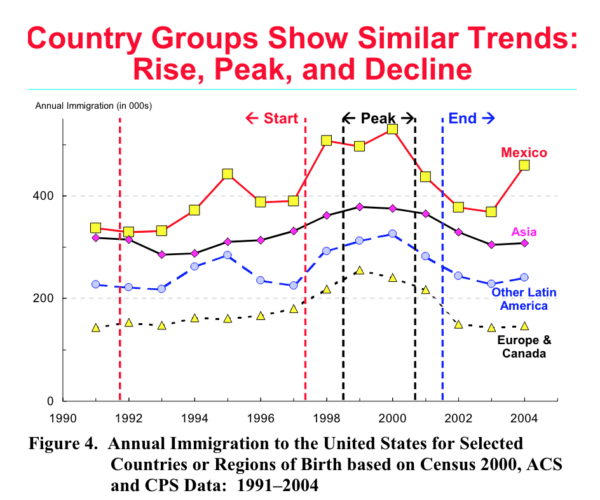Commentary
Mexicans have a saying, “Tan Lejos de Dios, y Tan Cerca de los Estados Unidos”: “So far from God, so close to the United States.”
It works the other way, too. Mexico’s policies directly affect the United States, and especially California, with its large population of immigrants from Mexico, as well as other Latin American countries.
On June 2, the people of Mexico elected Claudia Sheinbaum as president in its general election. Although news stories have concentrated on Ms. Sheinbaum’s being the first female and Jewish president of Mexico, what really matters is what her policies will be. For that, we’ll have to wait for not only her accession to power on Oct. 1, but also the results of the U.S. presidential election on Nov. 5. Then we’ll start seeing how the United States and California in particular are affected.
But we can start looking at what could happen. For now, I’ll address Ms. Scheinbaum’s economic policies. She belongs to the left-wing party called Morena, for Movimiento Regeneración Nacional, founded by outgoing President Andrés Manuel López Obrador. For the 2024 election, it joined several other left-leaning political parties in a coalition called Sigamos Haciendo Historia.
Mr. López Obrador, nicknamed AMLO, started six years ago as a left-wing advocate of tighter government controls but moderated somewhat. Still, a July 2023 review by David A. Gantz of the Baker Institute found that AMLO undermined the country’s favorable investments climate, which was already limited.
He reported: “Mexico will not quickly recover from López Obrador’s efforts to increase his grip on Pemex and the Comisión Federal de Electricidad (CFE), Mexico’s state-owned power utility, at the expense of the public, when private developers could have stabilized Mexico’s petroleum production and reduced reliance on dirty fuel oil for electric power generation. ...
“In my view, however, the greatest tragedy for Mexico of the López Obrador regime will be the squandering of the once-in-a-generation opportunity to encourage new foreign investment from multinational companies that have decided to reduce their reliance on China and relocate to Mexico rather than to Vietnam, India, or the United States. ...
“Despite the adverse climate, foreign investment in Mexico has continued. But much of it—originating from American and increasingly Chinese investors—resembles traditional maquiladora operations in the border states, focusing on low-tech production such as toys and furniture.”
Remembering the 1994 Peso Crisis
A previous spate of excessive government intervention, including a massive spending spree, led to the 1994 Peso Crisis, also called the Tequila Crisis.
Investopedia recounted the results: “On December 20, 1994, the Mexican central bank devalued the peso by 15 percent. To limit the excessive flight of capital, the bank also raised interest rates. Short-term interest rates rose to 25 percent, and the resulting higher costs of borrowing were a danger to economic stability.
“The Mexican government allowed the peso to float freely again two days later, but rather than stabilize, the peso took another sharp hit, depreciating nearly half of its value in the months that would follow.”
Inflation in Mexico reached 52 percent that year. By comparison, the United States has suffered nearly 20 percent inflation over the past three years.
Despite the United States organizing a $50 billion bailout, “Mexico suffered through a severe recession and bouts of hyperinflation in the years following the crisis, as the country maintained excessive levels of poverty for the remainder of the nineties,” Investopedia reported.
The Tequila Crisis also led to a large increase in immigrants to the United States from Mexico. A 2005 study for the Pew Hispanic Center, “Rise, Peak, and Decline: Trends in U.S. Immigration 1992-2004,” by Jeffrey S. Passel Roberto Suro, found the numbers increased to 450,000 in 1995 from 325,000 in 1993, as the crisis dug in.
After a lull in 1996–1997, they soared again to a peak of more than 500,000 in 1998–2000. They started dropping only as the dot-com recession hit the United States in 2001. Meanwhile, immigration from the rest of Latin America, Asia, and Europe was lower and didn’t fluctuate as much.

(Pew Hispanic Center/Screenshot via The Epoch Times)
Immigration 2025
The biggest wild card is the American presidential election. The Epoch Times reported: “President Joe Biden announced on June 4 an executive order that would shut down asylum requests at the southern border once the average number of daily encounters exceeds 2,500. ... [It] marks the latest of several recent moves by the administration to curb an immigration crisis that’s seen as a key issue by many voters heading into November.”
Whatever President Biden’s new policy brings, the Trump administration’s policy of completely closing the border and deporting illegal immigrants would be much stricter.
Another aspect is nation of origin. A November 2023 Pew study, “What we know about unauthorized immigrants living in the U.S.,” found that 10.5 million “unauthorized immigrants” were in the United States in 2021.
“The population of unauthorized immigrants from Mexico dropped by 900,000 from 2017 to 2021, to 4.1 million,” the study stated.
Thus, 39 percent of illegal immigrants in this country in 2021 were from Mexico, and 61 percent were from other countries.
If former President Donald Trump assumes office and ends illegal immigration, that means not just Mexican illegal immigrants would stay home or be sent back home, but the same would happen to those from other countries. An unknown number of those might be staying in Mexico, forcing Ms. Scheinbaum to deal with the problem.
And if her economic policies damage the Mexican economy, the crisis could be multiplied by her own “border crisis” of all those wannabe immigrants kept south of the border.
Costs to California
In January, The Epoch Times published a story headlined, “Free Health Care for Illegal Immigrants Could Cost California Billions Per Year: The newly enacted state law could cost taxpayers between $3 billion and $6 billion per year, according to recent estimates by state and federal lawmakers.”
And in March 2023, a study by the Federation for American Immigration Reform found that the illegal immigration cost to U.S. taxpayers was $150.7 billion. To California taxpayers, the cost was $30.9 billion.
If Ms. Scheinbaum’s policies send more illegal immigrants to California, then those costs will increase. However, if former President Trump is elected and keeps his promises to halt illegal immigration, and even deport the illegal immigrants here, then those costs likely would drop.
As in Mexico, in the United States, elections have consequences.









